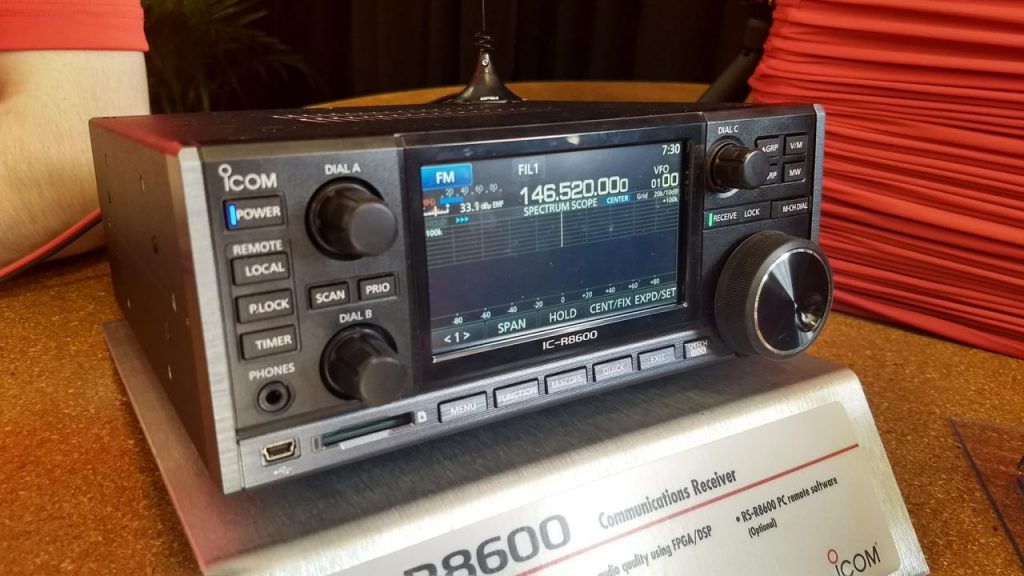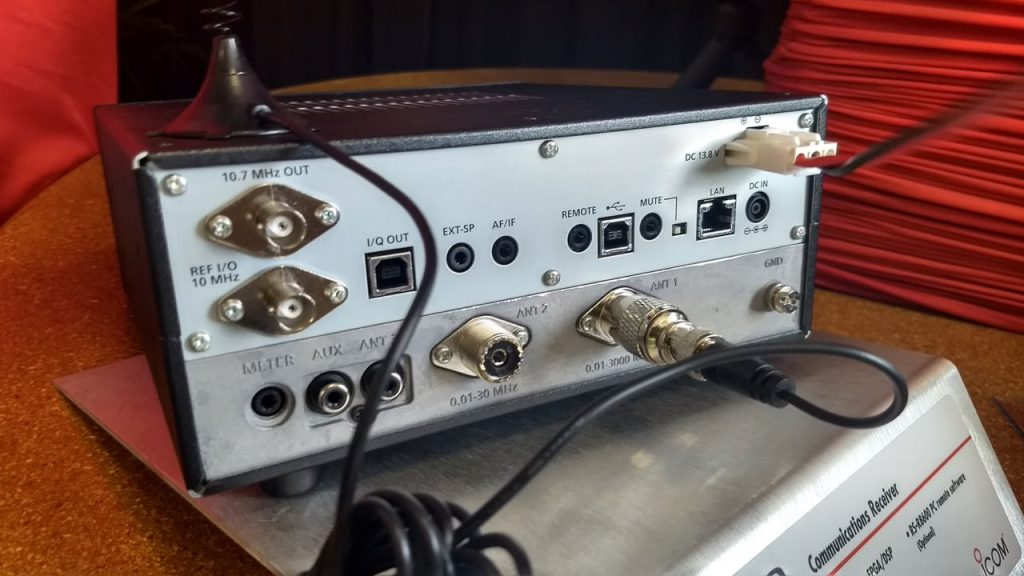At the 2017 Hamvention, I spent a little time checking out Icom’s latest wideband communications receiver: the IC-R8600. Check out the photos above and below.
I spoke with Icom North America at Hamvention–the representative told me the MSRP of the IC-R8600 would be about $2,999 US, but that retail pricing would be lower.
Universal Radio now has the IC-R8600 in stock with a retail price of $2599 US. HRO has the IC-R8600 in stock as well and selling for the same price.
No doubt, at this price point, the ‘8600 is not ideally placed to compete with other receivers and SDRs. I do, however, believe this product will do well with government sales. No doubt, it should deliver benchmark performance (at least one would expect benchmark). Icom has offered to send me an IC-R8600 on loan for a review–it is tempting to see how it might stack up against some of my SDR arsenal.
I’m very curious Post readers: assuming benchmark performance, how many of you would purchase the IC-R8600 at $2,599 US? Please comment!



Hi all.
I’m a newby to radio.
Had an Hammarlund Radio about 20 some years ago.
The more reviews I read, the more like it and may go for it.
And may go with the SP-39AD Speaker.
But for Antenna I got no Ideas what to get.
I would prefer an indoor antenna.
On the photo with the back of the receiver, it shows a indoor magnetic antenna.
On top of the radio.
What kind is this, and is it any good.
I understand that outdoor is better, but in my neighborhood, is not a choice.
Thanks
I was also very excited about the IC-R8600 and had saved money toward purchasing one.
Already have an IC-7300 and I am very pleased with it.
The R8600 was to sit alongside it to make a very nice stand alone SDR monitoring post.
But the price here in Australia is $3425 from local Icom dealers.
Well above the $3000 budget limit.
Yes I could sell some other items to make up the shortfall, but….
No DMR.
Absolutely ridiculous to leave this mode out.
It has replaced MANY analogue systems and is the most popular digital mode by far here.
So I have decided to give the R8600 a miss, since the IC-7300 does an excellent job on HF.
P25 here is mainly trunked and any conventional systems are encrypted. No Phase II decode is a head scratcher too.
DStar is nice, but of limited interest.
dPMR is non existent.
DCR as above.
NXDN decode is good, but again much of it here is trunked.
DMR is everywhere and is a very needed inclusion in a cutting edge receiver that commands north of $3000.
Sorry Icom, you have lost me with this one.
Earlier this year I was excited about this reciever. I’d played with the IC-7300 and really liked it for SWLing HF. Alas I couldn’t wait and got the 7300. Thiough I’ve made some amateur contacts with it, I still prefer using my full KX3 line. The 7300 is an awsome SWL rig for HF and if thats your primary monitoring interest, then its a bargin at more than $1k less than the 8600.
I agree, Len, that the IC-7300 is a worthy HF Broadcast DXing rig!
Sometimes I think the major manufacturers of shortwave receivers should pool some money, buy one of the defunct shortwave broadcasters and start a 24 hour general information and music service. I would call it a “reference” radiostation to demonstrate what shortwave radio is about to newcomers.
What I hope to see soon are some tests and reviews that delve into the non-typical SWL monitoring strengths of this receiver. I use a multitude of RTL-SDR’s and an SDRPlay RSP1 to monitor ADSB, ATC, L-Band satellite (aero, Safetynet, and Outernet), NOAA geostationary sats, railroad ATCS, several ham modes and others. The R8600 is a mystery at present since the early videos and discussions are not addressing the utility monitoring strengths, which you might think would be a major focus of this broadband receiver.
Issues that need to be resolved for me:
— As a SWL if I wanted to monitor shortwave broadcasts below 30 MHz I probably wouldn’t be interested in this radio unless that was secondary and the higher frequency performance was superior to anything on the market in the price range. At this point I am skeptical that the performance at HF and lower frequencies would justify the cost. I use an IC-7600 for my VLF to HF monitoring and would trade up if the high frequency performance is significantly better than and as versatile as the SDR’s and software consoles I am currently using on my computers
— Based on what I have been able to discover, if you don’t use the I/Q output, bandwidth settings required for some modes, e.g. NOAA polar orbiting sats on FM, cannot be set wide enough . Hopefully the I/Q output would allow the use of current software providing that flexibility.
— I am not an engineer, but looking at the block diagram in the ICOM brochure representing a high-level view of the receiver architecture, the fact that over 30 MHz there is a lot of signal processing taking place before the first A/D conversion, and in those ranges the receiver front end is basically a superhet design, does cause some concerns about performance. Those more knowledgeable than I am will eventually address this. So time will tell.
Likely we’ll see in the very near future some in-depth reviews that will help us understand if ICOM has produced a really useful hybrid design that can meet the needs of utility monitoring in the higher frequency ranges. If it is also a very good SWL receiver, so much the better — but the latter would not in itself seem to justify purchasing this unit.
Richard – you cannot buy any receiver that goes straight into the ADC at all frequencies. I think the current maximum for direct sampling is around 60 MHz (apart from highly expensive specialist receivers), so they all use hybrid superhet front ends above 30/40/50/60 MHz. My AOR 5001d is a direct sampler up to 25 MHz and hybrid above this, all the way up to 3.4 GHz.
As long as the front end filtering is adequate there should be no major problems.
snowballs chance in mauritius, even if lottery winner me…in future.
It is richly priced. At that price I would expect coverage from lowest long wave khz to multi ghz all mode , but then again it is beyond me for any level of features.
Edward, it covers 10 KHz to 3 GHz. I don’t know of another consumer RX that does that apart from the very expensive Winradio, and that doesn’t have any digital modes.
Well that solves the features problem, but more than I paid for my last car.
I have a Ten Tec Eagle. Its RX is outstanding for SWL listening as well as the ham bands. There is no way I would spend $2,599 for any receiver.
Thomas, at $2599 it is just a bit too much for my budget. I was expecting something around $2k and might have jumped on one at that price point. Since I’m mainly interested in HF, I canceled my pre-order with HRO and picked up a JRC NRD-535D instead.
—
Mike
Back in the mid 1950’s when I was a wee SWL lad, my receiver was a Hallicrafters S38C. I would often tune in Marine radio cw traffic. Managed to copy some of it. Now, there is very, very little and even the amateur cw bands lack what was there years ago. Fortunately still a fair amount. If the marine cw traffic was today what it was then, I would seriously consider this receiver. As it is, I operate QRP with my old FT-817D. That will do me until I go SK. 73/72 de F8WBD.
Actually I think it looks quite nice! Trouble is it doesn’t have DMR, so it’s a non-starter for me. A huge amount of PMR in the UK is DMR.
Good point, Andy. I can’t understand why manufacturers don’t try to include all of the popular digital modes–I’m certain it’s possible.
It looks cheap and tacky!! I’d rather buy two 8500’s over that
That’s probably due to my photos, Tony. At the time, I used my smart phone to take these and was chatting the whole time. I didn’t check the results until after the Hamvention.
The IC-R8600 feels like a quality product–the chassis is metal and the front faceplate a hard plastic like that of the IC-7300 and other similar transceivers. The buttons have a tactile response and the built-in color display is easy on the eyes–crisp and readable in sunlight. I also like the encoder–nice fluid action with (I believe) brake adjustment. Of course, I’d expect all of this at the $2500 price point.